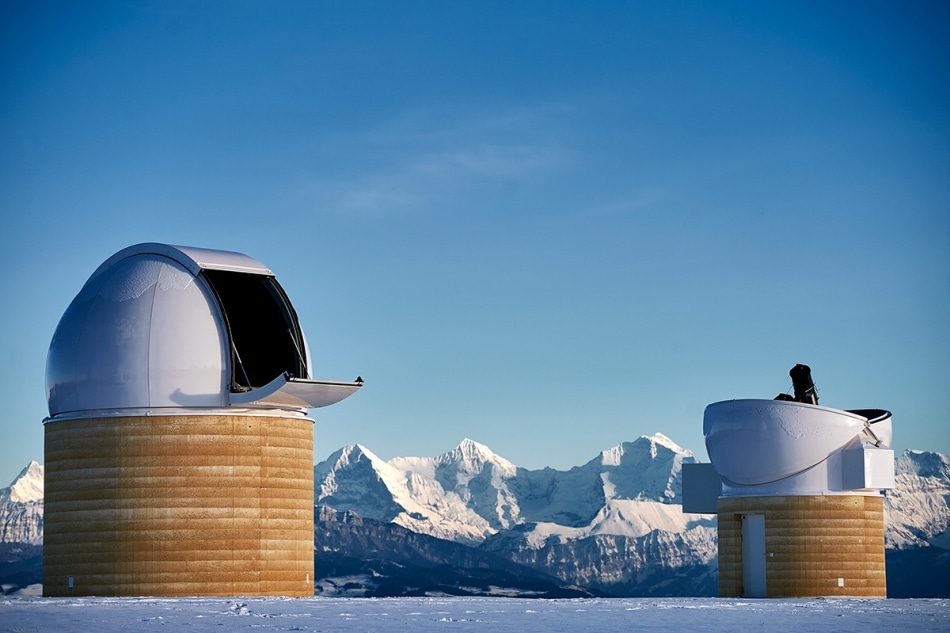May 22 2018
The Astronomical Institute of the University of Bern (AIUB) has renovated a dome and has also added two more domed structures, which extend its observatory in Zimmerwald. Consequently, six fully automated telescopes are now available for observation and particularly for detecting and recording space debris. As a result, the research station is gaining even more international importance under the name "Swiss Optical Ground Station and Geodynamics Observatory".
 The two new domes of the Zimmerwald Observatory with 5,3 m (left) and 4,5 m (right) diameter. (Image credit: University of Bern / Manu Friederich)
The two new domes of the Zimmerwald Observatory with 5,3 m (left) and 4,5 m (right) diameter. (Image credit: University of Bern / Manu Friederich)
One afternoon on 10 February 2009, Iridium 33 - the operational communications satellite - crashed with the obsolete Cosmos 2251 communications satellite over Siberia at an estimated altitude of 800 kilometers. The crash occurred at a speed of 11 kilometers per second, generating a cloud of over 2,000 pieces of debris that measured larger than 10 centimeters. Within a few months, this debris spread out over a large area and since then, has been threatening to hit other operational satellites.
"This incident was the ultimate wake-up call for all satellite operators but also for politics," states Director of the Zimmerwald Observatory Thomas Schildknecht. The issue of space debris - obsolete artificial objects present in space - took on a new dimension. For almost five decades, space agencies and experts have already been dealing with this issue. At the University of Bern, scientists deliver empirical and scientific bases for measures and models in order to stabilize the number of objects and to ensure that space is used in a safe and sustainable way in the future as well.
Findings Thanks to Highly Complex Measurements
Intricate observations using ground-based optical telescopes and radar systems are important to gain a better insight into the present space debris population. With these kinds of measurements, larger objects can be frequently followed and their orbits can be established. While the orbits of about 20,000 objects, at altitudes between 300 and 40,000 kilometers, are known currently, only statistical data is possible for pieces measuring smaller than 10 centimeters. These measurements denote a total of about 700,000 debris objects between 1 and 10 centimeters in size.
"The pieces may be small but they are definitely still dangerous: a collision with a one-centimeter diameter piece, for example, will release the energy of an exploding hand grenade," says Schildknecht.
At the Astronomical Institute of the University of Bern (AIUB), researchers used telescopes at the Zimmerwald observatory near Bern, under the name "Swiss Optical Ground Station and Geodynamics Observatory" and also a European Space Agency (ESA) telescope on Spain’s Tenerife to look for these types of tiny space debris pieces circling the Earth in high altitudes. Besides the orbit regions (at an altitude of about 20,000 km) of the navigation satellites, the "geostationary ring" region at roughly 36,000 km altitude is also being studied in more detail.
The satellites in this region appear to stay “fixed" with regards to Earth, and can hence invariably observe the same region of the surface of the Earth (weather satellites) or discharge signals to the same region - that is, communication satellites. Since the geostationary region is heavily used, it is already thickly populated which further raises the risk of collision. Therefore, the space is restricted which may cause conflicts between satellite operators and also between states.
Pollution of Near-Earth Space Increasing
Over the last two decades, AIUB researchers have identified innumerable pieces of debris with the aid of these measurements, such as a new, unanticipated population of extremely light objects. Upon closer analysis of these individual objects, it was concluded that they are debris from foils utilized for thermal insulation of the satellites. These outcomes make a major contribution to the models, which not only describe current space debris population but also act as the starting point for computing future scenarios.
Over the next few decades, all the models denote a sudden increase in today’s space debris population. A number of measures will be required to bring down this increase, for instance removing objects from the key regions toward the end of their mission (for instance, by allowing them to burn up in the Earth’s atmosphere), preventing collisions (employing avoidance maneuvers), and perhaps actively removing old and obsolete upper rocket stages and satellites with the aid of a clearing-up robot.
The New Telescopes at Zimmerwald Observatory
Thanks to the renovation of the existing six-meter dome and the two newly constructed domed structures, three new telescopes of the latest generation have been installed to study and view the current space debris population. Using one of these instruments with two, 40 cm, wide-field telescopes, debris objects in the geostationary ring can be permanently visualized to log their orbits.
The latest 80 cm telescope fulfills the needs to detect tiny small pieces of debris and establish their properties, and thus their origin, with the use of spectroscopic measurements. In association with the German Aerospace Center (DLR), a telescope is being set up and tested in one of the two newly built domes. In autumn 2018, this instrument will be taken to Australia to establish a worldwide optical network along with a current DLR and AIUB telescope in South Africa.